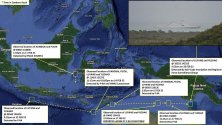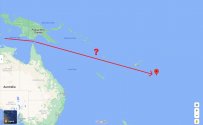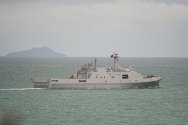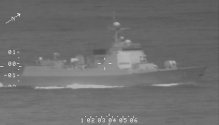What Australia did is a provocation. Australia shouldn't fly spy aircraft in the South China Sea.
You are using an out of date browser. It may not display this or other websites correctly.
You should upgrade or use an alternative browser.
You should upgrade or use an alternative browser.
PLA Navy news, pics and videos
- Thread starter Jeff Head
- Start date
And I call on Singapore to stop providing harbor for Australian military aircraft.What Australia did is a provocation. Australia shouldn't fly spy aircraft in the South China Sea.
This whole English commonwealth alliance thing is anachronistic.
It says the two PLAN ships then proceeded to enter the Coral Sea. Didn't seem to necessary say they're destroyers or warships though, I wonder what they could be. Maybe a Type 815G ELINT ship?What Australia did is a provocation. Australia shouldn't fly spy aircraft in the South China Sea.
The links you posted don't indicate Ka-28 have an advantage over S-70 in range or loiter time. More importantly, Z-20 has a more powerful engine than the most recent version of H-60. That's why it can also carry more fuel and payload than H-60. There is no reason it will have worse loiter time or combat radius or ceiling than Ka-28. After all, it was tested at Tibetan highland with great performance. There is no reason a new helicopter like Z-20 with latest engine, motor system and material should have worse flight performance than a Soviet era helicopter.As capable as the Z-20 is likely to become, the inherent limitations of its airframe by its very nature as an S-70 derivative means it simply doesn't compare against the Ka-28 in range and payload capacity.
On the other hand, the Z-20 is a quick, high-flying and nimble beast, which is never in dispute. And like @Icloo said, range and payload aren't everything.
The PLAN probably sees the Z-20's pros worth the trade-off, with self sufficiency no doubt being a critical factor, despite the apparent advantages the Ka-28 brings. It goes without saying the quality of its sensor suite is gonna make all the difference for the eventual Z-20 ASW.
That said, the new Ka-27M for the Russian Navy (and the export Ka-28M) with its Kopyo-A sensor suite looks to be a quite potent ASW platform with much expanded multi-role capabilities (ASuW, AEW etc.) as well:
What I find particularly interesting is its greater surface and sub-surface detection capabilities which are clearly designed to one up the USN's mainstay MH-60R --
250km and 2,624ft for Kopyo-A on the Ka-27M
vs
200km and 2,500ft for AN/APS-153 / AQS-22 on the MH-60R; and a whole host of other goodies.
Depending on how satisfied the PLAN will be with the Z-20, me still thinks the Ka-27/8M could be an option that's worth a gander down the road.
The fact that PLAN bought Ka-31 for carriers and then relegated them to DDGs (using Z-18 instead) should tell you how highly PLAN thinks of Ka-27/28/31 line of helicopters. As I said, even Z-9C is favored in PLAN over Ka-28. The Russian electronics/combat system is extremely weak. There is no way Z-20 can be inferior to whatever is being used on the latest Ka-28.
Kamov was never a popular choice for plan, the coaxial design is simply flawedPretty much the usual sources:
I, of course, cannot attest to the absolute accuracy therefrom, and likewise for their respective avionics and ASW suites.
Still, as a general guide in terms of raw specs the differences between the platforms are quite stark in some respects, such as range, payload, MTOW etc. like mentioned, whereas the SH-60 i.e. S-70 i.e. Z-20 edges out in speed and service ceiling, and maybe flight time. It's all I could discern from comparing the two anyway.
Reporting quoting AU government says its an 052D and an 071 LPD. Not clear to me the LPD image is of the actual vessel but DDG image certainly seems to be.
View attachment 83101
View attachment 83102

A 071 (999 if that's not a stock photo) escorted by what looks like the Hefei (174) passing through the Torres Strait into the Coral Sea ... does it seem like they were heading for Tonga? Maybe a second relief convoy? Pretty far-off for the PLAN sailing this close to Australia if it isn't.

As capable as the Z-20 is likely to become, the inherent limitations of its airframe by its very nature as an S-70 derivative means it simply doesn't compare against the Ka-28 in range and payload capacity.
On the other hand, the Z-20 is a quick, high-flying and nimble beast, which is never in dispute. And like @Icloo said, range and payload aren't everything.
The PLAN probably sees the Z-20's pros worth the trade-off, with self sufficiency no doubt being a critical factor, despite the apparent advantages the Ka-28 brings. It goes without saying the quality of its sensor suite is gonna make all the difference for the eventual Z-20 ASW.
That said, the new Ka-27M for the Russian Navy (and the export Ka-28M) with its Kopyo-A sensor suite looks to be a quite potent ASW platform with much expanded multi-role capabilities (ASuW, AEW etc.) as well:
What I find particularly interesting is its greater surface and sub-surface detection capabilities which are clearly designed to one up the USN's mainstay MH-60R --
250km and 2,624ft for Kopyo-A on the Ka-27M
vs
200km and 2,500ft for AN/APS-153 / AQS-22 on the MH-60R; and a whole host of other goodies.
Depending on how satisfied the PLAN will be with the Z-20, me still thinks the Ka-27/8M could be an option that's worth a gander down the road.
Most of China's destroyers and frigates can't take a z-20 anyways , so the ka-27/Z-9 will still have a future in the fleet.
What does having powerful engines have to do with fuel and payload space in an airframe? For that matter, the Z-9 isn't even in the same ballpark as Ka-28 or even Z-20 in that regard.The links you posted don't indicate Ka-28 have an advantage over S-70 in range or loiter time. More importantly, Z-20 has a more powerful engine than the most recent version of H-60. That's why it can also carry more fuel and payload than H-60. There is no reason it will have worse loiter time or combat radius or ceiling than Ka-28. After all, it was tested at Tibetan highland with great performance. There is no reason a new helicopter like Z-20 with latest engine, motor system and material should have worse flight performance than a Soviet era helicopter.
The fact that PLAN bought Ka-31 for carriers and then relegated them to DDGs (using Z-18 instead) should tell you how highly PLAN thinks of Ka-27/28/31 line of helicopters. As I said, even Z-9C is favored in PLAN over Ka-28. The Russian electronics/combat system is extremely weak. There is no way Z-20 can be inferior to whatever is being used on the latest Ka-28.
The Z-9 only matches the Ka-28's range at the expense of having less than 1/3 of the MTOW, and half that of the Z-20's, hence why it doesn't even carry sonobuoys, nor MAD. The Z-9/C is a utility SAR helo first, ASW helo second., if even that. It makes little sense to send a Z-9C out for sub-hunting when you have a Ka-28 at your disposal.
And what does an AWAC Ka-31 have to do with ASW?
Last edited:
What does it tell you that PLAN would rather use more the smaller Z-9C with its small payload rather than Ka-28 in the ASW role? You still haven't been able to answer my question. Ka-28 is an old helicopter with high maintenance cost and bulky/unimpressive sonar suite. They have no interest in more. They bought some Ka-31 when they lacked AEW helicopter. It was so unimpressive that they went for the Z-18 platform. What do that tell you? The ka-28/31 platform does not suit PLAN's needs. The sensors on them don't meet PLAN requirements.What does having powerful engines have to do with fuel and payload space in an airframe? For that matter, the Z-9 isn't even in the same ballpark as Ka-28 or even Z-20 in that regard.
The Z-9 only matches the Ka-28's range at the expense of having less than 1/3 of the MTOW, and half that of the Z-20's, hence why it doesn't even carry sonobuoys, nor MAD. The Z-9/C is a utility SAR helo first, ASW helo second., if even that. It makes little sense to send a Z-9C out for sub-hunting when you have a Ka-28 at your disposal.
And what does an AWAC Ka-31 have to do with ASW?
Z-20 is currently the most advanced helicopter in PLAN. The powerful engine allows it to carry heavy payload while retaining high speed and operate in the toughest environment. It was designed all along to be the naval helicopter of the future for PLAN.
All the new 052D, 055s and larger ships can use Z-20s. They have plenty of Z-9s/Ka-28s for the older fleet. If they wanted more Ka-28/31s, they would've purchased those long ago.Most of China's destroyers and frigates can't take a z-20 anyways , so the ka-27/Z-9 will still have a future in the fleet.


